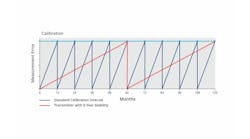Like every other element of digital transformation in the industrial space, edge computing is in a constant state of flux. And during his “Next In Tech” presentation at ROKLive 2021, Kris Dornan, Rockwell Automation marketing manager for machine, process and safety controllers, provided an update on shifting customer needs and the new solutions to meet them.
“The edge is transforming, including the devices, the connectivity of those devices, and where computing capability needs to sit,” he explained. “We are architecting the right infrastructure using edge products for performance, reliability and security.”
Dornan detailed how today’s industrial PCs are utilizing edge computing in innovative ways, relying on cloud computing or the on-premises approach, depending on the needs of manufacturers. Central to these discussions is protecting the data as it flows from its source to the visualization platform and making sure this information is delivered in a manner that operators and engineers can use it to make better decisions.
Make it secure. Make it contextualized so it can be put to work.
Of course, as Dornan phrased it, the distribution of information from edge to the cloud also entails increased cybersecurity risks. He listed how modern approaches entail:
- Embedded cybersecurity that provides protection at the fundamental root-entry points for intruders (“external and internal intruders”), which is particularly important as the cybersecurity attack surface continues to expand.
- The digitalization and emergence of affordable hardware focused on closing the loop between data extraction and value creation.
- Enterprise systems absorbing plant-floor computing with the tighter integration of IT and operational technology (OT), realizing real-time synchronized manufacturing operations. “But the need for computing is not going away,” he clarified. “There are still problems that require this compute power.”
- Advances with networking capabilities and the Ethernet (both wired and wireless). Dornan labeled Ethernet “the workhorse network of choice throughout manufacturing and production.”
- Connected products driving customers toward low latency operations. “We want to work in real time, not be waiting. Scheduled maintenance is still effective, but with new system intelligence, the system can order replacements on its own.”
Closer to “where the magic happens”
The terms “scalable computing” and “edge computing” can be used interchangeably, said Dornan, addressing how Rockwell creates solutions in this space that bundle the right hardware with the right software, prioritizing the ability to scale solutions for customers, which enables the greatest gains. “We can move these solutions up from the device level to the system level, then ultimately to the enterprise level, either in a private or public cloud setup, on-premises or remotely administered.”
To exemplify such solutions, the marketing manager presented three hypothetical use cases.
Use Case 1: The customer needs a way to embed a custom application on an operating system without the need for a white-box computer that must be managed by her IT department.
Solution: Rockwell Automation’s ControlLogix compute module, which enables her to use computer-software programs to build a next-generation algorithm that takes advantage the newest computing languages, which the upcoming generation of engineers is using for their automation strategies. “We can combine the best of these new code-building strategies with those that we have long been using.”
Use Case 2: The customer needs a human-machine interface (HMI) that displays content from various devices and applications.
Solution: Rockwell’s VersaView industrial computer, which employs a thin client architecture capable of managing various anti-virus applications.
Use Case 3: The customer needs a controller that can meet high-demand motion applications while at the same time be accessed using Studio 5000 Logix Designer for maintenance purposes.
Solution: Rockwell’s CompactLogix 5480 controller, built to handle this marriage of operating systems while bundling software and hardware.
Dornan closed his ROKLive presentation with an explanation of why his team uses the Windows 10 IoT Enterprise OS Long-Term Service Branch, a specialized edition of Windows 10 Enterprise that promises the longest intervals between feature upgrades of any Windows operating system (OS). He explained how Rockwell Automation worked with Microsoft to identify the proper OS for its industrial-control applications. “It’s built for the hardened environment, which is critical and why it was selected,“ he said.
“All of this technology is changing, quickly, at a very high level,” Dornan summarized. “We at Rockwell Automation are staying ahead of the curve and looking at how we can take advantage of these new technologies to create unique solutions when it comes to customers’ control architecture and algorithms. Customers have problems and they are looking for insights. They rely on a vendor like Rockwell to deliver solutions that make sense.”
Dornan’s full presentation, entitled ”Transformation of the Edge: Architecting Infrastructure for Performance, Reliability and Security,” remains available on demand through October 2021.




